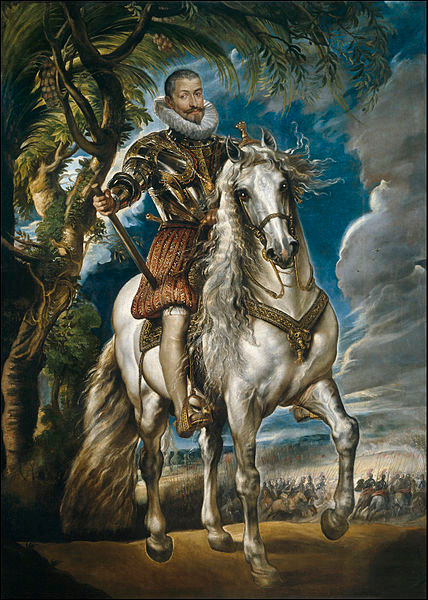 Peter Paul Rubens (1577-1640) was a Belgian painter and diplomat. This dramatic portrait of the Duke of Lerma was painted in 1603 while Rubens was in Italy.
Peter Paul Rubens (1577-1640) was a Belgian painter and diplomat. This dramatic portrait of the Duke of Lerma was painted in 1603 while Rubens was in Italy.
Don Francisco Gómez de Sandoval (1552/3 – 1625) was a favorite of Phillip III of Spain. Phillip II had worried the noble would take advantage of his son. History provides a divided opinion as to whether or not Sandoval used his favor with Phillip III to his personal advantage or was a loyal advisor to the young king. King Phillip III would elevate Sandoval to the Duke of Lerma in 1599 and the Duke would become the King’s most trusted advisor.
The Duke would become a powerful statesman. Nobles and the wealthy were thought to have showered him with gifts to curry his favor. Whether this stunning portrait of the Duke riding as if to battle on a fine white stallion was one of those gifts is unknown. To my untrained eye, the horse is the real star of this painting and the man sitting astride his back is just along for the ride. The long and thick flowing mane, upright ears, thick tail and stance of the horse exemplify the Andalusians Spain would often use as a tool of diplomacy. Rubens would later in his life maintain a fine stable and enjoy evening rides on his own prized Andalusian.
The young king, who favored festivals and prayers over most everything else would see his power erode as his son, Phillip IV, himself perhaps corrupted by an older and stronger advisor would seek to overthrow his father. As the country fell into bankruptcy, Lerma issued a number of policies that were ruinous to the country but lined his own pockets. However, much of wealth that he amassed was spent on religious houses, rather than on his own excesses.
The Duke’s position also eroded and he was compelled to leave the court in 1618. Months earlier, perhaps knowing the end was coming to Phillip III’s rule, Lerma had persuaded Pope Paul V to make him a cardinal. Phillip IV set out to destroy Lerma but Pope Gregory XV defended him. The cardinalcy protected him from prosecution. Lerma’s secretary, not protected by such a high station within the church, would be tortured and executed in his stead. Lerma would be sentenced to return over a million ducates to the state. He died less than a year later and there was no indication whether or not he paid the fine.
Rubens had been sent on a diplomatic mission to Spain in 1603 to meet with Phillip III. It was likely that the artist and the Duke met during that trip.